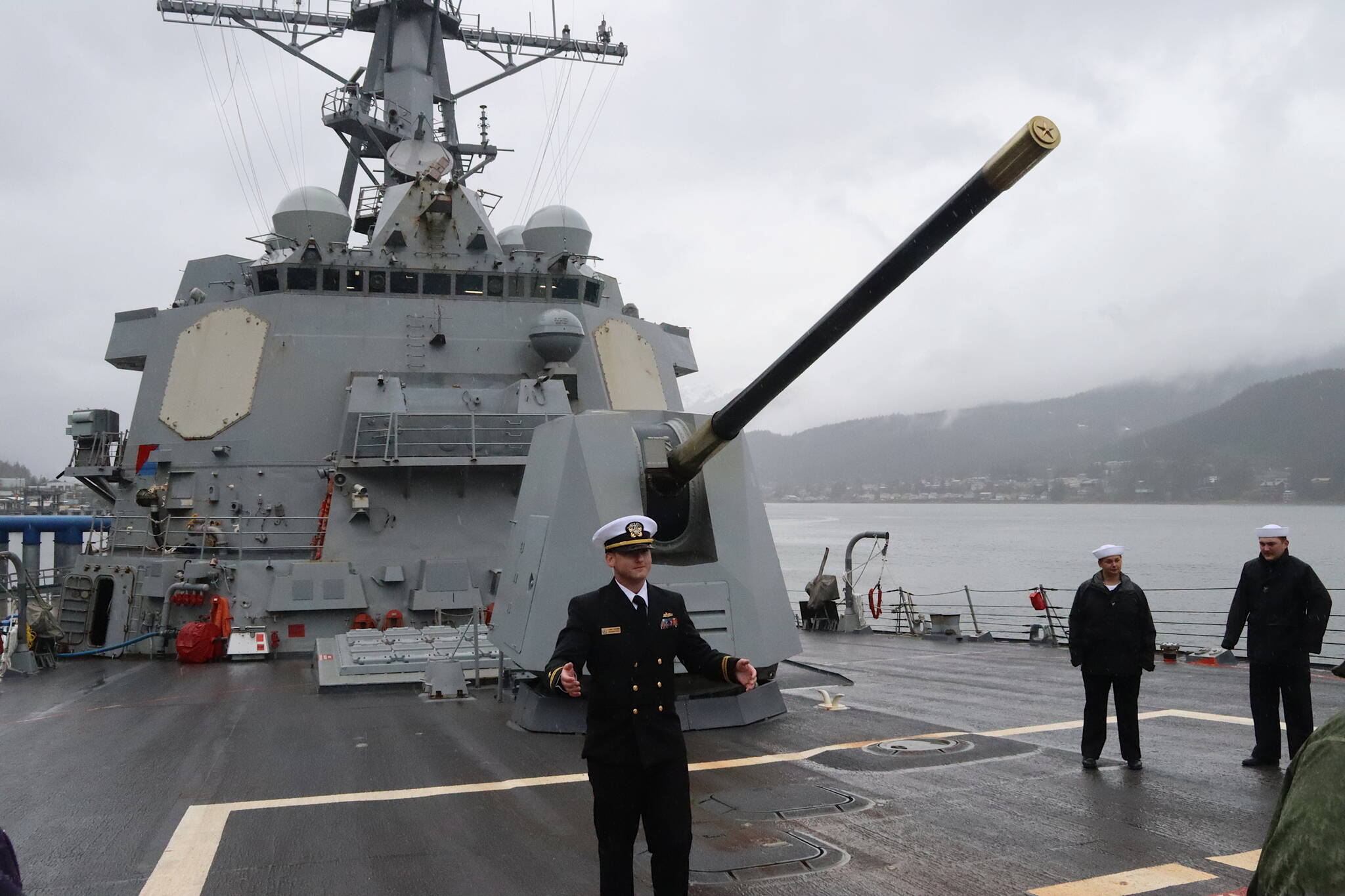Crew assigned to the U.S. Navy’s USS William P. Lawrence say Juneau residents have been exceptionally welcoming since the ship arrived at the downtown cruise dock on Saturday, which considering the capabilities of the 510-foot-long guided-missile destroyer is probably well-advised.
“We can shoot 13 miles, so if you look out at the horizon anything is within our capability,” said Karissa Schulte, a fire controlman third class, explaining the 5-inch/54-caliber Mark 45 gun on the foredeck to a group of about 20 people taking one of many public tours offered Sunday.
The William P. Lawrence is scheduled to remain in port until Wednesday for what Cmdr. Robert Wayland, who became the ship’s commanding officer a week ago, called a “community engagement” visit timed to coincide with Saturday’s annual Juneau Maritime Festival. The last visit by a Navy ship to Juneau occurred in 2017.
“It’s very important that we connect with all the communities that support the Navy and I think so that they can understand, hopefully through engagement with the sailors when they’re out in town, what it is that we do for the taxpayers, and how we provide support to the country and trade in places that may not see Navy ships very often,” he said.
In addition to daily public tours, crew members — besides taking some recreational shore leave — are planning to participate in a number of community events including school visits, trail work and helping the Southeast Alaska Food Bank, Wayland said.
Public tours are available from 9:30 a.m. to 4 p.m. Monday and Wednesday, and from noon to 4 p.m. on Tuesday, according to an announcement from Navy Public Affairs. There will be no admittance to the existing tour waiting line after 3 p.m., security screening measures are in place and long waiting lines are possible.
Multiple groups were aboard the ship at any given time Sunday morning, including two tours provided to state legislators in addition to those provided to a growing line of people at the dock’s terminal. A tour that included a few media members among other residents was led by Lt. Daniel Schuerman, the ship’s operations officer, who took the group to various exterior portions of the ship where various features — weapons most prominently among them — were explained.
The heart of the two-shaft vessel consists of four General Electric LM2500-30 gas turbines that can achieve a speed exceeding 30 knots, placing it among the ten fastest ships in the U.S. Navy’s fleet.
“This a Ferrari, this is not a Toyota Corolla — we can churn and burn with the best of them,” Schuerman said, admitting to a couple of people in an aside later he owns a Corolla and hence the oft-used quip.
While visitors were given only words to grasp the range, destructive power and thousands-of-rounds-per-minute speed of the biggest guns aboard, an opportunity was provided to handle one of the (unloaded) four .50 caliber heavy machine guns on the port side of the ship. That opportunity was seized, so to speak, mostly by younger participants in the tour — with the youngest being Ripley Wallace, a toddler wearing a jacket adorned with smiling hearts to shield her from occasional heavy rain, with the help of her father Tyler Wallace.
Among the official deployments by the William P. Lawrence was sailing with the 7th Fleet in the South China Sea in late February, which the U.S. was “trying to keep open and free for maritime trade, Wayland said.
“That’s kind of our bread and butter mission there,” he said.
The tour didn’t include the ship’s interior — where media members were also asked not to take photos for security reasons — which Wayland said is partially for the sake of the privacy of the 330-member crew. He said there is plenty of curiosity expressed by visitors about the living conditions, food and other aspects of everyday life aboard the ship, but residents taking the tour won’t be missing any remarkable sights.
“The berthing compartments are pretty austere for the sailors, so we do our best to keep them in the best condition that we can,” he said. “But yeah, they are typically in bunks that are stacked three high. And then there’s common head sinks and showers for the team. So it’s tight quarters on board because most of the space that you see is given over to either engineering stuff or over to weapons systems.”
Wayland, who joined the Navy in 2001 at the age of 19, is commanding his second ship after being the commanding officer of the USS Pioneer, an Avenger-class minesweeper stationed in Japan. He became an executive officer aboard the William P. Lawrence two years ago, with his command of the vessel scheduled to last for the next 18 months.
“As a kid I was always interested in the Navy and reading about World War II — in particular Battle of the Atlantic kind of things — and I just always thought it was fascinating,” he said. “I’ve always enjoyed being on the water.”
For people considering such duty, “it’s not an easy life in some ways, but it can be remarkably rewarding,” Wayland said. Among those rewards are lots of travel and the possibility of college assistance.
“That is a huge benefit today to be able to get a college degree paid for, in addition to learning probably some pretty interesting skills,” he said. “We have extraordinarily skilled sailors onboard who operate very complicated electronic mechanical equipment. And they’re learning real skills that they can go out into the private sector after, whether it’s one enlistment or a full career in the Navy, and make a very good living.”
• Contact Mark Sabbatini at mark.sabbatini@juneauempire.com or (907) 957-2306.

